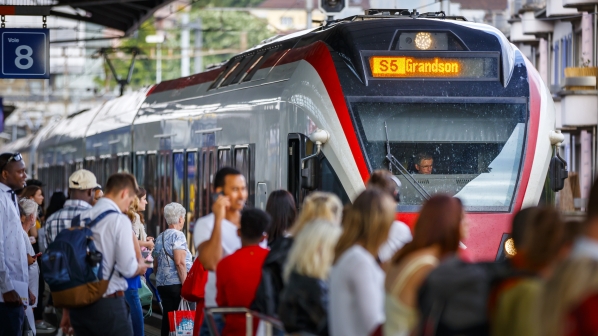SAUDI Arabia’s ambitious Landbridge project, an east-west, port-to-port railway from Jubail and Damman on the Persian Gulf to Jeddah on the Red Sea via Riyadh, has finally taken a key step forward. A consortium of Italferr, Sener and Hill International were confirmed as the preferred bidder for a project management consultancy contract last month. 20 years after the project was conceived, construction could finally get underway later this year.
The Saudi Landbridge is one of the projects to watch in this special issue of IRJ. Progress here is another sign that the Middle East rail market has sparked back into life. The Gulf Cooperation Council (GCC) added further fuel to the fire by announcing December 2030 as the completion date for the trans-Arabian GCC Railway to connect Kuwait, Saudi Arabia, Bahrain, Qatar, the United Arab Emirates and Oman.
This landmark project hit the buffers in 2014 when the oil crisis prompted GCC governments to pull back their respective plans to build new cross-border railway infrastructure. Inter-regional disputes, particularly between Qatar and the rest of the Gulf region, also dampened enthusiasm for the GCC project. Yet as Mr Raouf Ghali, CEO of Hill International, told me (p46), this situation has largely been resolved and he now sees ample opportunity in the region; Hill is in discussion over other Saudi construction projects. The company is also eyeing opportunities in Oman and rail schemes in Qatar and the UAE.
“The strength that the market is coming back from those countries, and potentially others as well, is really refreshing,” Ghali says.
Growing confidence among Gulf governments to build new railway infrastructure reflects the long-term desire to diversify their economies away from oil and gas. There is also increasing recognition of the need to invest in more sustainable modes of transport, reflecting policies in other regions.
The climate crisis and decarbonisation are key factors driving new railway investment.
The UAE Consensus, the output document of COP28, which was held in Dubai in December, included commitments to transition away from fossil fuels for the first time. While not committing to a total phase out, as many environmentalists had hoped, this is still an encouraging step. Sustainable transport, including rail, can also take heart from the document’s acknowledgment of the need to “accelerate the reduction of emissions from road transport on a range of pathways” and the commitment to triple renewables and double energy efficiency.
The climate crisis and decarbonisation are key factors driving new railway investment. Yet Ghali suggests that the Covid years “were a missed opportunity” to get ahead of the curve on new infrastructure construction, which in the case of transport could have really accelerated this transition. But with deadlines looming to allocate post-Covid economic stimulus packages, many projects around the world are poised to take significant steps forward in the coming 12 months.
This in the case in Europe where sustainable transport projects are receiving €85bn of the €750bn European Union Recovery Fund. There is, however, still much work to do if rail is to get anywhere close to achieving the objectives for modal shift outlined in the European Commission’s Sustainable and Smart Mobility Strategy of December 2020. Among these targets is doubling high-speed rail traffic and increasing rail freight volumes by 50% by 2030. Looming updates to the Combined Transport Directive, the only piece of European legislation governing intermodal transport, are intended to boost rail freight. The Green Transport Package announced in summer 2023 also includes revisions to legislation governing the use of infrastructure capacity in the Single European Rail Area that could boost network capacity by up to 4%. Rail associations and lobby groups are pushing for the swift adoption of these proposals following the long-awaited recast of the TEN-T network last month. Efforts to boost competition through the Fourth Railway Package are also paying off. Expect some progress here in the next 12 months.
In the United States, passenger rail and transit investment is entering a golden period in light of the $US 106bn allocated from Biden administration’s $US 1 trillion Infrastructure Investment and Jobs Act. 2024 also promises to be a big year for private rail infrastructure investment in the US, notably Brightline West to build a high-speed railway between Las Vegas and southern California. Momentum might also be restored to Texas Central, the high-speed project between Dallas and Houston.
US support for infrastructure investment stretches beyond its own borders. Ambitious plans to develop a new trans-Persian corridor from India via the GCC to the Mediterranean were agreed in September. A similar agreement has also been reached to support the redevelopment of the Lobito corridor in Angola. African governments are rightly looking for a better deal than they have got from China in the last decade or so and the West’s growing attempts to counter the Belt and Road Initiative should drive up delivery quality all round.
China inevitably remains influential in Asia - there is sure to be strong interest from Chinese firms and financiers in the revived Kuala Lumpur - Singapore high-speed project. This follows the recent success with the cross-border line from Kunming to Laos and the Jakarta - Bandung high-speed project in Indonesia. Domestic railway development is also continuing at pace, especially in western China.
Geopolitics are similarly driving railway developments in central Asia, specifically in developing alternatives to trans-Asian routes through Russia. Kazakhstan, a major beneficiary of the upturn in east-west freight volumes in recent years, is investing big to improve connections with its neighbours and this looks set to continue.
Inevitably the upturn in activity raises questions about skills and the industry’s capacity to deliver. These will remain big talking points over the next 12 months. Thankfully many of the challenges posed by high rates of inflation and supply chain issues that have impacted the industry in the post-Covid years are finally beginning to ease. Indeed, there is a lot for the sector to feel buoyant about. Welcome to The Railway in 2024.

